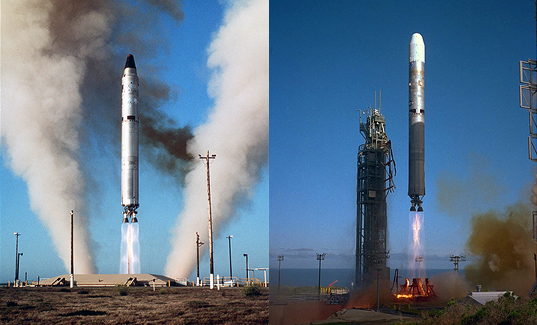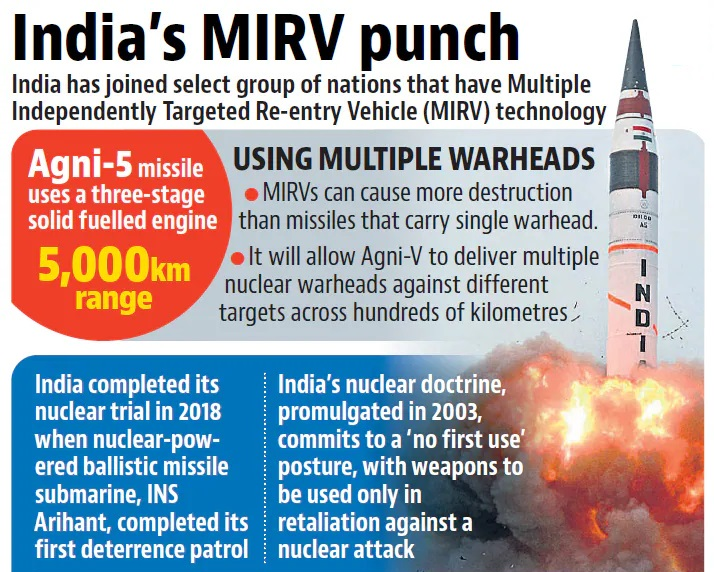Description

Copyright infringement not intended
Picture Courtesy: https://tutorials.nti.org/delivery-system/understanding-missiles/
Context: Pakistan claims that India violated the Agreement on Pre-notification of Flight Testing of Ballistic Missiles by failing to provide a full three-day advance notice of its recent missile test.
Details
- Pakistan expressed concern about India's recent missile test, which included the indigenous Agni-5 missile equipped with Multiple Independently Targetable Re-entry Vehicle (MIRV) technology, indicating a significant advancement in India's missile capabilities, allowing it to carry multiple nuclear warheads on a single missile.
- With this successful test, India joins an exclusive group of nations that have such advanced systems. The Agni-5's incredible 5,000-kilometre range could bring targets in Asia and parts of Europe within striking distance.

Agreement on Pre-notification of Flight Testing of Ballistic Missiles
- India and Pakistan signed the Pre-notification of the Flight Testing of Ballistic Missiles Agreement in 2005.
- This agreement aims to reduce the potential miscommunications and miscalculations between the two neighbours. It promotes predictability and transparency by mandating prior notice of ballistic missile test flights.
Key Points of the Agreement
- Each party must notify the other party in advance of any planned flight test of surface-to-surface ballistic missiles launched from land or sea.
- Each party shall notify the other party at least three days before the start of a five-day launch window for ballistic missile flight tests.
- Each party must issue relevant NOTAMs (Notice to Airmen) and NAVAREAs (Navigational Warnings for Mariners) via their respective authorities.
- Bilateral pre-notification must be sent through the respective Foreign Offices and High Commissions, using the format attached to this Agreement.
- Test launch sites must not be within 40 kilometres of the International Boundary or the Line of Control, and projected impact locations must not be within 75 kilometres of these boundaries.
- Ballistic missiles' projected trajectory must not cross the International Boundary or the Line of Control, and a horizontal distance of at least 40 kilometres is required from these limits.
- Parties must keep bilateral pre-notification confidential unless otherwise agreed.
- The Parties shall conduct discussions annually or as mutually agreed upon to examine the implementation of this Agreement and consider modifications.
- A party may withdraw from the agreement by giving the other party six months' written notice.

Conclusion
- The Agreement on Pre-notification of Flight Testing of Ballistic Missiles aims to increase transparency and confidence between India and Pakistan about ballistic missile testing, thereby contributing to regional stability and security.
Must Read Articles:
INDIA-PAKISTAN RELATIONS: https://www.iasgyan.in/daily-current-affairs/india-pakistan-relations-6#:~:text=In%20the%20aftermath%20of%20cross,India%20on%207%20August%202019.
|
PRACTICE QUESTION
Q. Consider the following statements in the context of the Agreement on Pre-notification of Flight Testing of Ballistic Missiles, signed by India and Pakistan:
1. Each party shall notify the other party at least three days before the start of a five-day launch window for ballistic missile flight tests.
2. Test launch sites must not be within 40 kilometres of the International Boundary or the Line of Control.
3. A party may withdraw from the agreement by giving the other party six months' written notice.
Select the correct answer using the code given below:
A) 2 only
B) 1 and 3 only
C) 3 only
D) 1, 2 and 3
Answer: D
|







